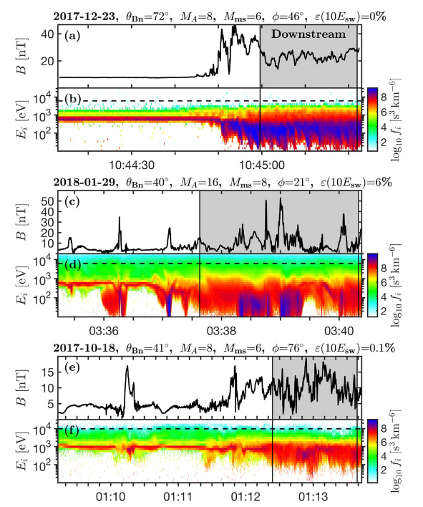A. Johlander, M. Battarbee, A. Vaivads, L. Turc, Y. Pfau-Kempf, U. Ganse, M. Grandin, M. Dubart, Yu. V. Khotyaintsev, D. Caprioli, C. Haggerty, S. J. Schwartz, B. L. Giles, M. Palmroth
Abstract: Collisionless shocks are some of the most efficient particle accelerators in heliospheric and astrophysical plasmas. Here we study and quantify ion acceleration at Earth’s bow shock with observations from NASA’s Magnetospheric Multiscale (MMS) satellites and in a global hybrid-Vlasov simulation. From the MMS observations, we find that quasiparallel shocks are more efficient at accelerating ions. There, up to 15% of the available energy goes into accelerating ions above 10 times their initial energy. Above a shock-normal angle of ~50°, essentially no energetic ions are observed downstream of the shock. We find that ion acceleration efficiency is significantly lower when the shock has a low Mach number (MA < 6) while there is little Mach number dependence for higher values. We also find that ion acceleration is lower on the flanks of the bow shock than at the subsolar point regardless of the Mach number. The observations show that a higher connection time of an upstream field line leads to somewhat higher acceleration efficiency. To complement the observations, we perform a global hybrid-Vlasov simulation with realistic solar-wind parameters with the shape and size of the bow shock. We find that the ion acceleration efficiency in the simulation shows good quantitative agreement with the MMS observations. With the combined approach of direct spacecraft observations, we quantify ion acceleration in a wide range of shock angles and Mach numbers.
Read the full text: https://iopscience.iop.org/article/10.3847/1538-4357/abfafc/pdf

0 Comments